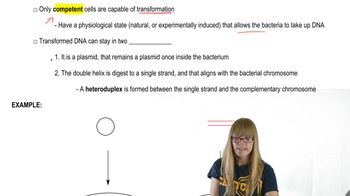Table of contents
- 1. Introduction to Genetics51m
- 2. Mendel's Laws of Inheritance3h 37m
- 3. Extensions to Mendelian Inheritance2h 41m
- 4. Genetic Mapping and Linkage2h 28m
- 5. Genetics of Bacteria and Viruses1h 21m
- 6. Chromosomal Variation1h 48m
- 7. DNA and Chromosome Structure56m
- 8. DNA Replication1h 10m
- 9. Mitosis and Meiosis1h 34m
- 10. Transcription1h 0m
- 11. Translation58m
- 12. Gene Regulation in Prokaryotes1h 19m
- 13. Gene Regulation in Eukaryotes44m
- 14. Genetic Control of Development44m
- 15. Genomes and Genomics1h 50m
- 16. Transposable Elements47m
- 17. Mutation, Repair, and Recombination1h 6m
- 18. Molecular Genetic Tools19m
- 19. Cancer Genetics29m
- 20. Quantitative Genetics1h 26m
- 21. Population Genetics50m
- 22. Evolutionary Genetics29m
8. DNA Replication
Overview of DNA Replication
Problem 8
Textbook Question
How did Kornberg assess the fidelity of DNA polymerase I in copying a DNA template?
 Verified step by step guidance
Verified step by step guidance1
Understand that fidelity in DNA replication refers to the accuracy with which DNA polymerase copies a DNA template.
Recognize that Arthur Kornberg, who discovered DNA polymerase I, used several methods to assess its fidelity.
One approach involved using a known DNA template and measuring the incorporation of nucleotides to see if the correct complementary bases were added.
Kornberg also used radioactive labeling of nucleotides to track their incorporation into the newly synthesized DNA strand.
He compared the sequence of the newly synthesized DNA to the original template to identify any errors or mismatches, thus assessing the enzyme's fidelity.
Recommended similar problem, with video answer:
 Verified Solution
Verified SolutionThis video solution was recommended by our tutors as helpful for the problem above
Video duration:
1mPlay a video:
Was this helpful?
Key Concepts
Here are the essential concepts you must grasp in order to answer the question correctly.
DNA Polymerase I Function
DNA Polymerase I is an enzyme responsible for synthesizing new DNA strands by adding nucleotides complementary to a DNA template. It plays a crucial role in DNA replication and repair, ensuring that the genetic information is accurately copied. Understanding its mechanism is essential for assessing its fidelity in copying DNA.
Recommended video:
Guided course

Functional Genomics
Fidelity in DNA Replication
Fidelity refers to the accuracy with which DNA polymerases replicate DNA. High fidelity is critical to prevent mutations, which can lead to genetic disorders or cancer. Factors influencing fidelity include the enzyme's ability to select the correct nucleotide and its proofreading activity, which corrects errors during DNA synthesis.
Recommended video:
Guided course

Steps to DNA Replication
Experimental Assessment Techniques
Kornberg employed various experimental techniques to assess the fidelity of DNA Polymerase I, such as using labeled nucleotides to track incorporation and analyzing the resulting DNA for errors. These methods allowed for quantifying the accuracy of nucleotide incorporation and identifying the frequency of misincorporation events, providing insights into the enzyme's performance.
Recommended video:
Guided course

Transformation

 5:02m
5:02mWatch next
Master Directionality with a bite sized video explanation from Kylia Goodner
Start learning


